FAQ
The Planning Board publishes the most frequently asked questions (FAQs) to provide residents of the Ottawa River Basin and those living downstream of the river in the Montreal Archipelago with information on how integrated management of the principal reservoirs within the Ottawa River Basin is implemented, limitations of flow regulation, understanding the river’s flow regime, and other topics of interest.
These FAQs represent questions that have commonly been asked or address areas where the Planning Board feels additional information would be of interest to the public. Please send your comments, suggestions, and questions to the Ottawa River Regulation Secretariat.
Several factors influence the duration and magnitude of a spring freshet. The main factors are listed below. The list starts with the factors that may occur first and is not in order of importance:
- The recharge state of the water table at the end of winter;
- The amount of water contained in the snow on the ground before the start of spring melt;
- The speed of melt of the snow cover;
- The precipitation amounts and characteristics of rainfall events during the melting period.
It is important to state that these ‘factors’ are elements that contribute to flooding. They should not be considered ‘predictors’ of future floods. The snow cover, for example, changes constantly. As for rainfall, forecast of quantities to be received is not known until a few days and sometimes hours before it actually occurs. Accurate knowledge of quantities received is known only after the rain event.
Duration:
The duration of the spring freshet is determined by:
- The volume of water from the melting of the snow cover throughout the watershed;
- The rainfall that is received during the melting period.
It is impossible to know how much rain will be received more than a few days and even hours in advance. But certain factors that influence the melting snow volume may occur in the months leading up to the spring flood.
Soil Saturation: a rainy late fall and early winter with heavy rains and soggy soil during the winter frost can affect river conditions over winter and spring. In this situation, the soil will have a high degree of saturation and it will decrease the soil’s ability to absorb water from melting snow cover in the spring. Important winter thaws during which a portion of the snow cover melts can also have the same effect. In short, soil saturation helps to increase the volume of water in the river in two ways:
- By increasing the base flow;
- By increasing the portion of the melting snow cover that will turn into runoff.
Snow Water Equivalent: this is the amount of water held in the snow cover. The snow water equivalent just before the start of melting is important. A layer of snow that has diminished and become dense following freeze-thaw cycles may contain more water than a thick blanket of fresh snow. A significant part of the snow cover may also disappear by sublimation, a process similar to how snow disappears from roofs even though it is too cold to melt. This depends on late winter weather conditions, such as wind and sunshine. Also, mild weather periods in January or February may turn some of the snow cover into runoff. This runoff will leave the basin during the winter period. The water content of the snow cover at the beginning of March is normally a good first indication of the volume of water to come. To learn more about snowpack conditions, refer to ‘Current Conditions’. (Note: the snow map feature is available only from early February to the end of the freshet).
Magnitude:
The magnitude or strength of the spring freshet is also known as the peak flow. How high the peak flow is, determines how high peak water levels will be. The peak flow is determined by the precise time when maximum water from melting snow and rain moves through the river. The main factors influencing the size of the peak are:
- The speed at which the snow cover melts;
- The presence or absence of weather systems with heavy rainfall during the melting period;
- The duration and location of these systems.
The rainfall runoff from the northern part of the basin can take up to three weeks to flow through the watershed. This is because the basin is large and the river is very long. For this reason, the succession of unusual weather events can have a cumulative effect on peak flows — for example, heavy rain in the northern part of the basin, followed by heavy rain in the southern part of the basin a week later. The 2017 flood is a very good example of this phenomenon where two consecutive large systems affected the basin. Unfortunately, these rare systems can only be forecasted a few days in advance.
For more information on this topic, click here.
Weather conditions vary from day to day and from year to year. Many factors can affect spring floods, and no two floods are exactly alike. Meteorological conditions can look similar some years. However, different weather patterns, over different parts of the basin, drastically change the degree of flooding.
Two years that seem to have similar weather characteristics may have very different spring freshets. For example in the Lake Coulonge area, flooding occurred in 1985 and did not occur in 1984. Yet, both years had similar total precipitation.
Where precipitation occurs and if it falls over a short or long period can affect a particular location in different ways. In the case of flooding in the Lake Coulonge area, the peak flow of the Coulonge River in spring 1985 was about twice as large as that in 1984. Moreover, flooding on unregulated tributaries is a signal that received precipitation may begin to cause downstream flooding.
Another example is the depth and density of the snowpack, which is an indication of the amount of water contained in the snowpack and available to runoff in the spring. The length of time over which snowmelt occurs and sublimation, where part of the snow is going directly to the atmosphere, vary between years and this affects runoff amounts. Generally, the water contained in the snowpack is only one of several factors that can influence river conditions during the spring.
Flooding on the Ottawa River occurs naturally. Flooding is not expected to happen every year. In other words, spring floods do not systematically cause the river to overflow in the flood plain area. However, flooding is driven by weather conditions that can be cyclical. That’s why flooding can be cyclical too.
We often express how likely a flood is by using probability. During any given year, there are five chances in one hundred, or a 5% chance, of having a medium flood event (e.g. a 20-year flood) and there is a 1% chance of having a very large flood event (e.g. a 100-year flood).
Cyclical weather phenomena, such as La Niña and El Niño, can result in prolonged periods (i.e. more than one seasons) of wet or dry weather. There were several medium to large flood events in the 1970s, which were followed by a relatively flood-free period of nearly four decades. As shown in the figures below, periods of dry and wet weather have alternated in the past.
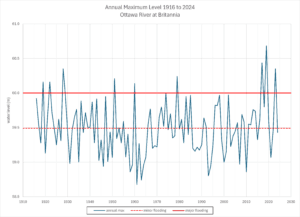
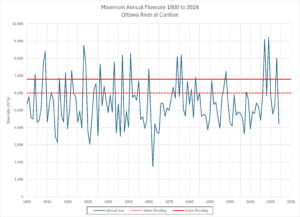
Climate change is expected to change streamflow patterns in many parts of Canada. The effect this will have on flooding will vary by location and may also change over time. Significant flooding along the Ottawa River occurred in the 1920s, 1950s, 1970s and more recently in 2017, 2019 and 2023. Flooding will occur again, but not every year. Natural variability of weather is such that periods of drier or near-normal weather are bound to occur again.
It is important for residents to be aware of where their property is located relative to the river floodplain. Many areas at high risk of flooding have been identified as early as the 1980s following the implementation of the National Flood Damage Reduction Program. Following recent flooding events, governmental programs are underway and several municipalities are benefitting from support to update floodplain maps such as the Plan de protection du Territoire face aux inondations of Québec and the 2018 federal program Federal Flood Mapping Framework.
During the fall, there is reduced evapotranspiration and soils remain wet longer after it rains and therefore cannot absorb as much rainfall as in the summer. When it rains, more water runs off (runoff), and flows to streams and the Ottawa River and causes water levels to increase.
In the fall, days become shorter and temperatures become cooler. This causes the vegetation to become dormant. Trees shed their leaves and vegetation stops growing. With less of a canopy, vegetation does not intercept rainfall as much or take up the water contained in the soil. This natural phenomenon leads to less water being evaporated from surfaces and less transpiration. Transpiration is when plants convert soil water into vapour. Reduced evapotranspiration rates mean that the soil remains saturated with water from rain over a longer period. Rainwater that does not seep into the soil is referred to as excess rainfall. This excess rainfall runs off the land and into lakes and streams. The water in streams eventually flows into the Ottawa River. In the fall, in most areas along the Ottawa River, the larger the volume of water flowing into the river, the higher the water levels will be. In the fall period, it is common to see water levels rise rapidly when heavy rainfall occurs over a significant part of the watershed.

Normal Flow Range of the Petawawa River in cubic metres per second
As shown in the figure above, this greater influence of rainfall on runoff during the fall leads to greater river flow variability and overall volume. This figure presents the normal flow range of the Petawawa River, a natural river that is not regulated by control structures. The green band in the figure represents the normal range of observed flow values and is made up of the flows observed in the river 80% of the time over a 30-year period (1991-2020). For a given day-of-year, the median (shown by the percentile 50% line) is the middle value of all the conditions observed in that 30-year period. The percentile 10% line and 90% line define the normal boundary. A wider green band means that flows vary more at this time of year. On the other hand, a narrower green band means that the conditions are less variable.
Similar to the Petawawa River, flows along the main stem of the Ottawa River will vary more in the fall. Operationally, principal reservoirs located in the headwater areas of the basin are full at this time of the year. All excess rainfall that results in increased reservoir inflows must pass through the reservoir system, as there is no available storage to retain that water. To learn more about dam management at the principal reservoirs, click here.
On the main stem of the Ottawa River, increased river flows do not require significant changes in operations at hydroelectric facilities. In the fall, water levels at hydroelectric facilities may be at the upper end of their normal operating range to meet recreational commitments. Increases in river flows may cause levels to rise and to exceed the normal operating range temporarily. These increased water levels are not associated with any flood risk. It is important to note that river conditions are monitored closely throughout the year. Should forecasts call for a possible risk of flooding, which is rare in the fall period, the levels at the main stem facilities are adjusted to make way for the natural runoff. For more information on these operations, refer to the FAQ 5.
In spring, the amount of runoff increases causing watercourses to swell. Natural narrows in the river, such as rapids, become more apparent during periods of high flows and make water levels rise throughout the river system. Just like water flowing through a funnel, water flowing through narrows is restricted and backs up as flows increase. The effects of these natural river characteristics impact upstream river sections and can extend upwards of more than fifty kilometres. Refer to Part C for more information about the effect of river characteristics on water levels.
During periods of high flows that cause flooding, the main stem of the river (between Lake Timiskaming and the Deux-Montagnes area) is considered unregulated. This is because in this section of the river water cannot be stored to reduce river flow or associated water levels. During a high-flow event, the high river flows combined with natural river characteristics determine the water levels in the river. Trying to hold back any water by maintaining higher water levels upstream of the dams would result in increased flooding for shoreline residents upstream of these structures. This can also make the dam structures that have a limited storage capacity at risk. Refer to Part D for more information about storing water along the main stem of the Ottawa River.
That is why facilities located below Lake Timiskaming, on the Ottawa River operate as run-of-river dams. As the river flow increases, most of these facilities must lower their upstream water levels. They do this to limit flooding in communities located upstream. They maintain water levels as close as possible to natural conditions —natural conditions as in before the generating stations and dam facilities were built.
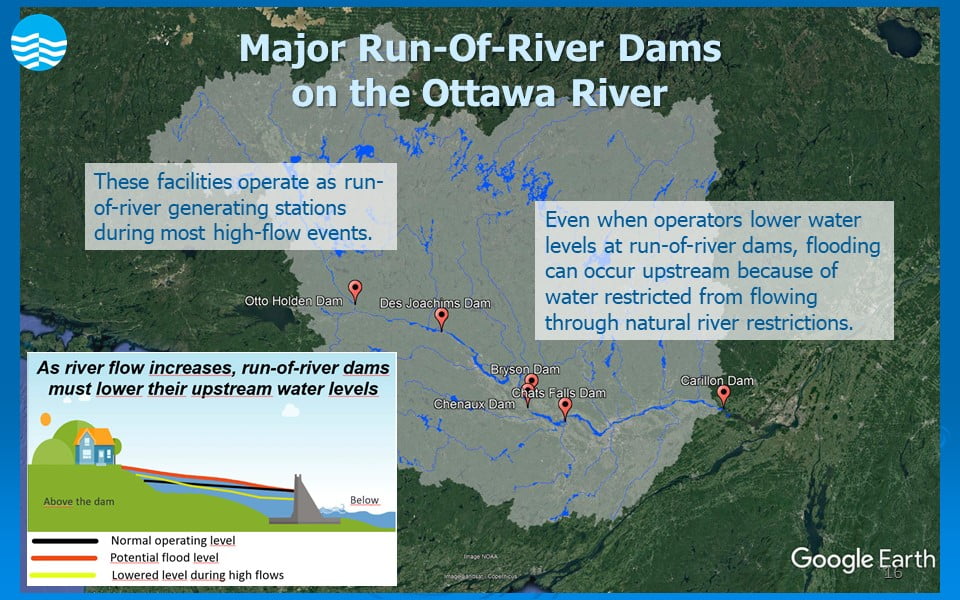
There are multiple dams and generating station facilities located between Lake Timiskaming and the Deux-Montagnes area. The text below provides a general description of how water is managed at those facilities. However, characteristics for each facility differ by location and it is best to contact each operator individually for specific information. For more information regarding water management at the Des Joachims (Swisha) facility, please refer to FAQ 6.
Part A: How are run-of-river facilities typically operated?
Run-of-river facilities cannot hold on to large quantities of water for a long period of time like principal reservoirs do. This is because they have minimal storage capacity.
At these facilities, before high flow periods occur, the level at the facility is lowered. It is lowered to ensure that upstream, naturally occurring flooding will not be made any worse during the high-flow event.
Once the level is lowered, the facility continues passing water that arrives at the dam. This is known as ‘passing inflow’. During this period when levels are kept low, the flow of water through the facility is the same as the flow of the river.
When passing inflows, operators increase the flow through a facility as the arriving river flow increases. Similarly, the flow through a facility is decreased when the flow of the river recedes.
A flow increase through a facility is generally done by removing logs from log sluices or opening control gates. A flow decrease through a facility is generally done by replacing logs in log sluices or lowering gates deeper into the water. Also, part of the flow passes through the generating station’s units (or turbines) that are located below the water surface. The amount of water flowing through the turbines can vary. This is why operations to increase or decrease the flow at a facility may go unnoticed.
Part B: Why is the water level in my area so high that there is flooding, while the water level in other areas is lower than usual?
Flooding can occur when the river flows are too high for the water to flow through the main river channel and water is forced onto the riverbanks or floodplain. In some areas upstream and near ‘run-of-river’ facilities, the opposite can happen.
Because the operators lower water levels to limit upstream flooding as explained in Part A, the water just above the dam appears to be unusually low. In those river reaches above the dam, docks may be inaccessible and riverbanks, which are normally covered by water in summer and fall, are dry.
This is what happened at Lac-Sainte-Marie in 2017. The lake in this area naturally drains to one section of the Gatineau River. In 2017, dam operators lowered the level in front of their dam located in this river reach due to forecasted high flows. Lowering the Gatineau River and draining Lac-Sainte-Marie was similar to draining a bucket for the deluge to come. See for yourself how this can look odd because of almost no water upstream and so much water downstream by watching this interview with Global News in 2017.
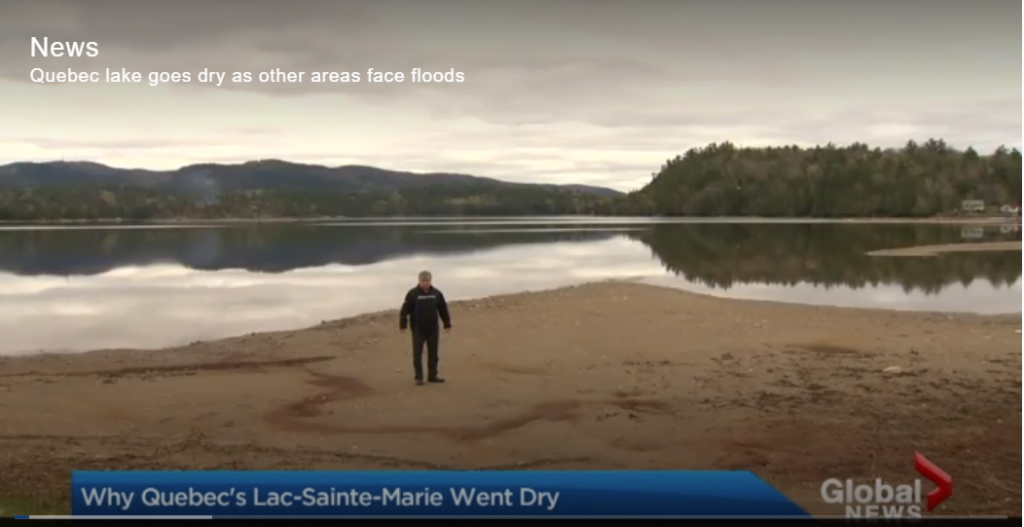
This is also what happened along the Ottawa River between Rolphton and Mattawa in 2017 and 2019 in the river section that is located upstream of the Des Joachims hydroelectric facility. For more information on water management at Des Joachims (Swisha) facility, refer to FAQ 6.
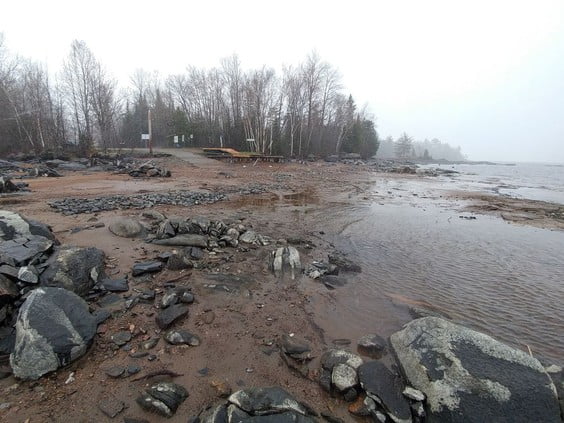
Part C: Why are operators of the Carillon, Chats Falls and Bryson dams not making water levels go down in my river reach when flooding is occurring between Gatineau (Hull) and Hawkesbury, on Chats Lake, or on Lake Coulonge?
Operators of Carillon, Chats Falls and Bryson would reduce levels in river reaches located upstream of the facility if they could, but, it is not physically possible to do so. Increased opening of gates and log sluices would not make water levels go down. In the flooded area upstream of these facilities, the water levels are determined by:
- High river flows;
- Physical characteristics of the river, in particular natural constrictions on the river.
During high flow periods, when flooding is occurring, operators of these three facilities reduce water levels immediately upstream of their dams. The lower level at the facility transfers control of water levels in flooded areas to natural upstream constrictions on the river. A natural physical constriction can be narrows, rapids or islands. These naturally physical constrictions existed before the dams were built.
In the spring, water levels on the river increase naturally. This is because the volume of water that flows into the river is increased by the natural runoff from snowmelt and rainfall. The natural constrictions on the river restrict the flow of water. Under natural flow conditions, river water levels increase as the flow increases.
There is no way to force water flow through the river system. It must flow out of a river section naturally. The speed is governed by the physical characteristics of the river, such as:
- The slope of the river bottom;
- The natural narrows such as rapids;
- The width of the river;
- The riverbed and bank type (for example rocks or sand).
The level at the facility needs to be low enough to ensure that the control point is maintained at the upstream natural section.
Part D: Why are the water levels on the Ottawa River not lowered sooner to prevent flooding? For example, in February.
Lowering water levels sooner would not change the magnitude of the spring freshet. Facilities that are operated as run-of-river dams during periods of high flows have small amounts of upstream storage. It requires only a few days to lower the level of the water that is held back immediately above their dams. In the spring, operators follow river condition forecasts very closely. They do this so that they know when the snowmelt runoff will cause river flows to increase significantly. They then lower water levels at their facilities in preparation for the increase in flow.
Lowering water levels at the run-of-river facilities in February when the river flows are low would result in low water levels for an extended period. Possibly a period of 10 weeks. At the onset of spring freshet, the increasing river flows would make the water levels to go back up at a time when flows are moderate and not high enough to cause flooding. Lowering levels in February then provides no benefit and does not reduce the flooding. Additionally, the storage volume available on the main stem of the river is far too small compared to the volume of water flowing through the river during high flow periods, to reduce flooding on the river system.
Flood impact reduction during the spring freshet and other high flow events is achieved mainly by storing the runoff. Every year, a portion of this spring runoff is stored in the thirteen principal reservoirs. These are the reservoirs subject to integrated management under the 1983 Agreement. Seven of these reservoirs can influence the flow of the Ottawa River between Rolphton and Fort-Coulonge. The 6 northernmost are from Lake Timiskaming and further north in the Abitibi area. These 6 reservoirs have a significant storage capacity. These are the first to be used in the regulation strategy for minimizing flood impacts. The timing of the refill at these locations is optimized to mitigate flooding all along the Ottawa River below Lake Timiskaming. The regulation strategy aims at storing the spring runoff from the northern part of the basin until the first peak on the Ottawa River is passed. This period of time is typically when flows in local uncontrolled tributary rivers reach their peaks and start to recede. Examples of uncontrolled tributary rivers include the Petawawa and Coulonge Rivers.
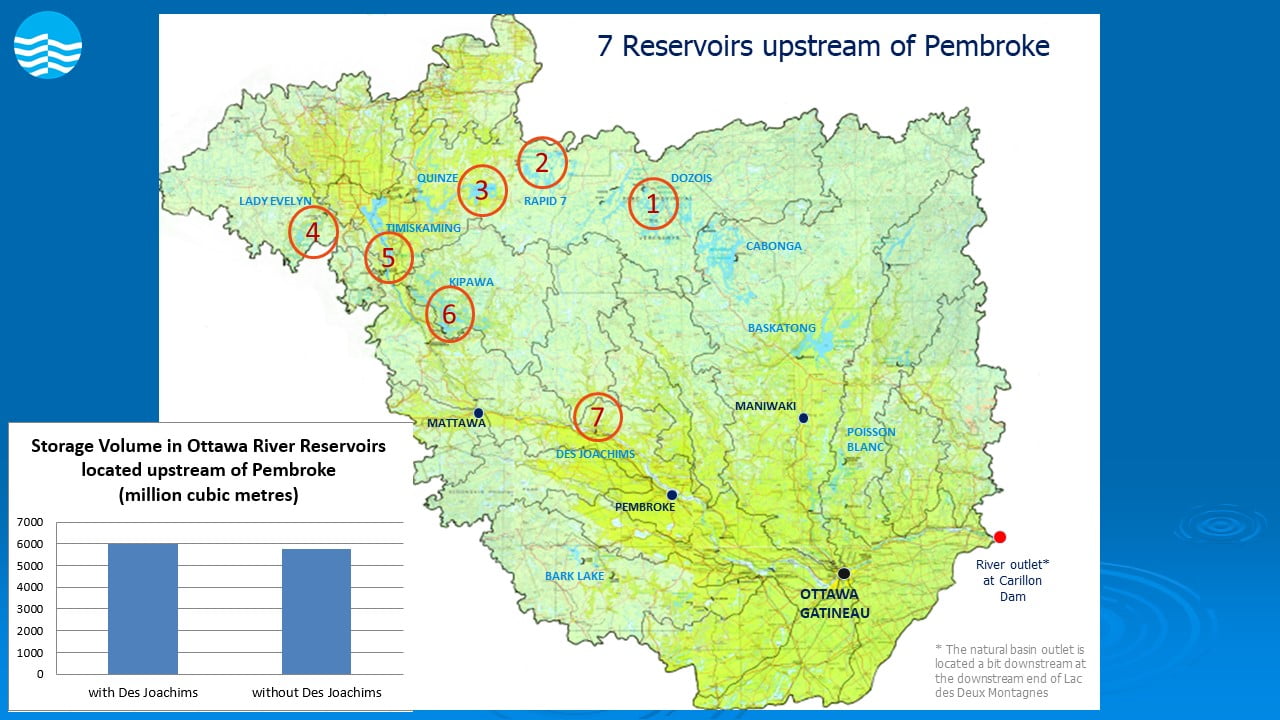
The Des Joachims facility would be the seventh and smallest reservoir. This reservoir can create a backwater effect all the way upstream to Mattawa. Therefore, the spring refill strategy at Des Joachims consists of two stages. The purpose of the two-stage refill is to reduce the risk of upstream flooding and provide some relief to flooding downstream areas.
During the first stage of the refill, water levels typically rise about halfway to the maximum level of the reservoir. This action assists with the mitigation of downstream flooding by using some of the available reservoir storage. This mid-reservoir level also enables low water levels to be maintained upstream of the facility and limits the amount of backwater effect. These low or natural levels at Deux-Rivières are sometimes only remembered by older generations that knew the river before Des Joachims was constructed in 1950.
The second stage of the refill involves filling the remainder of the reservoir. It is only completed once the probability of upstream flooding in Mattawa is reduced. This stage returns the reservoir to its normal operating levels.
Residents along Lake Coulonge will observe similar flood mitigation strategies at the facility located downstream of their locale — specifically, the lowering of water levels above the Rocher Fendu and Bryson facilities. At these facilities, water levels are maintained at a lower elevation during spring freshet when required. This is done to minimize upstream levels. For more information on typical operations at run-of-river facilities, refer to FAQ 5.
The timing and the degree to which different locations experience flooding depends on:
- Weather conditions over particular areas of the basin;
- Natural characteristics of the downstream river, such as narrows and rapids;
- The geographic location compared to the principal reservoirs in the north.
Weather conditions vary from year to year and across the watershed. For more information weather factors that contribute to flooding, refer to FAQ 1.
Yes. In 2019, melting of the deep snowpack in association with heavy rainfall caused historic floods on the Ottawa River and its tributaries.
In 2019, the water contained in the snowpack was twice that of a normal year in early spring. The spring was late with below average temperatures and snow still accumulating over much of the watershed in early April. With little sunshine and cooler than normal temperatures, there was little reduction in the snowpack during the early spring period.
There was twice as much rain as normal in April. A sequence of heavy rainfall events that started over the Easter long weekend added more runoff to streams. For example on April 18 2019, two major rainfall events from Colorado and Texas merged to bring 20 to 50 mm of precipitation over much of the Ottawa River Basin. These rainfall events brought additional water at a time when streams were already swollen by significant spring snow melt volume. These weather events were the first of many that would impact the watershed and increase flood levels. 2019 press releases available here.
Many tributaries of the central portion of the watershed (Petawawa, Coulonge, Madawaska, Petite Nation and Rouge rivers) had record-breaking flow rates. Other tributaries, such as the Mississippi and Bonnechere rivers also experienced significant flooding affecting communities along the length of their shores. Many smaller tributaries also experienced unprecedented high flows that washed away portions of roads and culverts. These combined flows provided exceptional quantities of spring runoff into the Ottawa River and caused the first flood peak to occur between April 29th and May 1st.
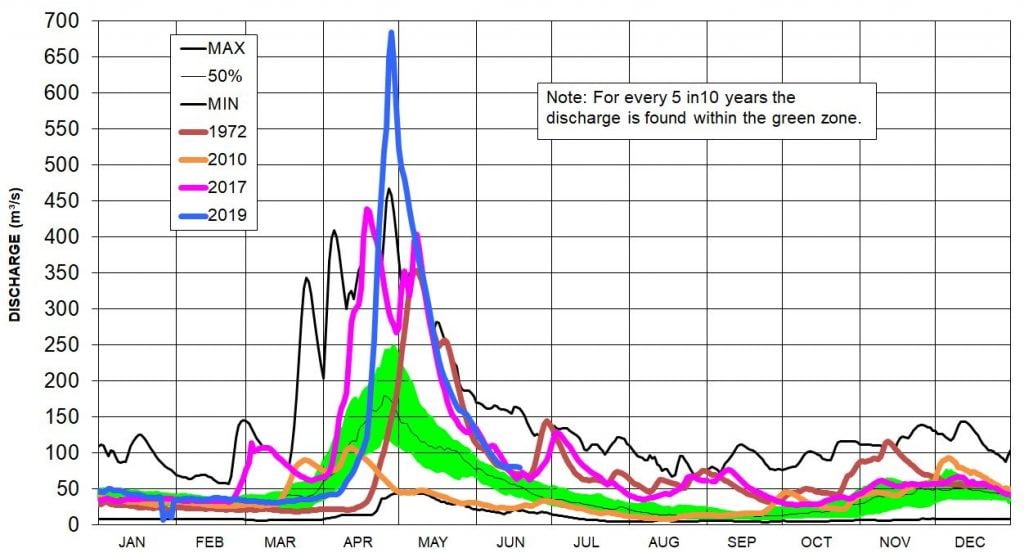
At certain times of the year, the Ottawa River has a considerable effect on the flows of the St. Lawrence River — especially in the Montreal archipelago area.
The Great Lakes ‐ St. Lawrence Regulation Office carries out the day-to-day regulation activities for the International Lake Ontario – St. Lawrence River Board. This is why the Ottawa River Regulating Committee and the Great Lakes ‐ St. Lawrence Regulation Office work together. The two groups liaise to share relevant flow forecasts of the Ottawa River.
Plan 2014 has no effect on flows and levels in the Ottawa River upstream of the Carillon dam because of these specific reasons:
- Existing river characteristics: It is physically impossible for water to back up into the Ottawa River upstream of the Carillon Dam. That is true under all water level conditions, even during flooding in the Montreal Archipelago (Lake St. Louis). The difference in water elevations upstream of the Carillon dam and those in the St. Lawrence River is too large. The difference in water elevations along the Ottawa River is illustrated in this figure.
- Large parts of the Ottawa River basin flows are not regulated: Excess water from precipitation or spring melt from the central and southern parts of the Ottawa River basin is not regulated. These parts of the basin represents 60% of the basin area. This means that even if dam operators wanted to hold back the amount of water flowing in the river, they could not. There is no available reservoir storage in those parts of the basin. Water levels along much of the main stem of the river are regulated during most of the year (that is, outside of high flow events). During the spring flood period, flows are regularly so high that the dams are operated as run-of-river facilities. They pass all arriving flow and cannot be subject to operational restrictions dictated by Plan 2014 on the St. Lawrence River. More information on the management of water at run-of-river dams is available in FAQ 5.
- Carillon Dam does not regulate upstream levels during flooding: Outside of the spring flood period the Carillon dam regulates the water level in the upstream river reach to Hull/Ottawa. The observed difference in water elevation between Hull/Ottawa and Carillon is approximately 50 cm. During the 2017/2019 spring floods, as shown in the figure below, that difference was approximately 450 cm (i.e. 4.5 m or roughly 15 feet). During large flood events, the amount of water flowing in the river combined with the effects of the natural river narrows at Grenville determines or controls the upstream levels. Those narrows (aka the Long Sault rapids) are located approximately 20 km above the Carillon dam. The Carillon dam is operated as a run-of-river facility during a high flow period. It allows all arriving upstream flows to pass. This ensures that upstream river levels will not rise above natural levels, those observed prior to construction of the dam, under the same flood flow conditions.
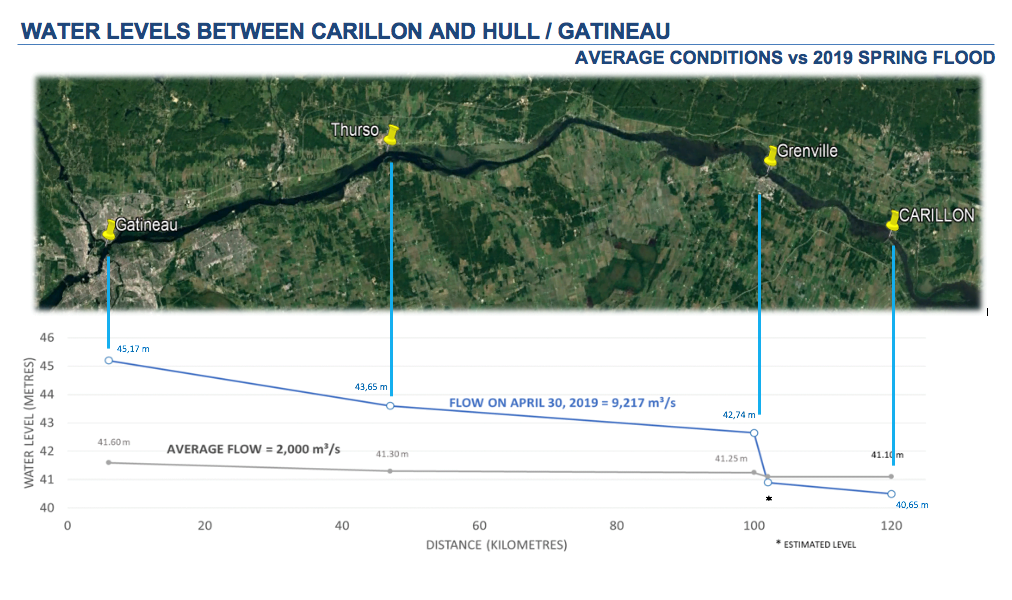
Québec and Ontario agencies involved in the management of the principal reservoirs on the Ottawa River make up the Ottawa River Regulating Committee.
The Regulating Committee communicates daily throughout the spring freshet season. As an example, fifty conference calls were held during the 2019 spring flood by this group.
Also, operators of the main reservoirs continually assess current and forecast river conditions.
The Regulating Committee also determines what actions can be undertaken to help reduce flood impacts (by increasing or decreasing flows of the principal reservoirs). It also communicates key information on river conditions to governmental agencies and the public.
No, hydropower generation is more efficient with a high water level upstream of the dam and low water levels downstream. During a flooding event, the opposite occurs. When there is a flood, water levels on the river are lowered upstream of the facilities to limit flooding in communities located upstream. The downstream water levels are naturally high due to high river flows. In terms of demand, the freshet period is not associated with high electrical needs. High electrical demand typically occurs in the winter or in the summer during heat waves.
Flood mitigation and public safety are the top priorities for water management activities undertaken by Hydro-Québec and Ontario Power Generation. This is especially true during the spring melt. Flood conditions are inefficient for producing hydropower. Also, flooding conditions result in excess water being spilled through gates and log sluices. Most flood waters do not pass through the generating turbines and therefore does not produce electricity. Flooding thus provides no benefit to Hydro-Québec or Ontario Power Generation.
No. All communities located downstream of the principal reservoirs benefit from the water that is stored and therefore prevented from flowing downstream during flooding.
Flood impacts in the Montréal Archipelago are mitigated by holding (or storing) spring runoff in the principal reservoirs to reduce the peak of flood flows in downstream areas. Since the major reservoirs are located primarily in the northern sectors of the Ottawa River basin and with water flowing north to south, all river sections benefit from water storage during the same flood event. Also, with peak flows occurring at different locations along the length of the river within two to three days of one another the benefits of the use of reservoir storage to reduce peak levels is applicable to the whole length of the river. For instance, on the upper Ottawa River, the town of Mattawa benefits from the presence of the six principal reservoirs located in the Abitibi-Timiskaming area, with flood flows being lower than would have occurred without the presence of the principal reservoirs. Similarly, residents of the river further downstream in communities such as Constance Bay on Lac Deschenes benefit from eight principal reservoirs storing water. With two principal reservoirs located on the Gatineau River and three located on the Lievre River that feed into the Ottawa River downstream of Lake Deschenes, the lower reach of the river between Lake Deschenes and the Hawkesbury – Grenville area benefits from the thirteen principal reservoirs, in the same way that the Montréal region eventually does.
Climate change, particularly the increased frequency of heavy rainfall events, is expected to make floods happen more often and be stronger in smaller watersheds or drainage systems, like those in cities. Some studies show that certain cities already face more floods because their drainage systems can’t handle the water from heavy rainfall well (see CBC News 2020, PNAS 2020). For big areas like the Ottawa River basin, it’s not so clear how climate change will affect floods. A study done by Ouranos in 2019 suggested that in a hundred years, there might be fewer flood risks along the Ottawa River, but that they could increase in the meantime (see Climate Dynamics 2019, Ouranos 2019 – French only). There’s a lot of uncertainty in these studies and we can’t be sure what future weather patterns the region will experience.
Floods can be caused by a mix of factors, like how much rain falls, the thickness of snow cover, how fast the snow melts, and how much water evaporates from the ground surface and vegetation. Climate change can affect each of these factors.
Here’s a simple breakdown:
- More Rain: Warmer air can hold more water (as humidity), leading to more rain. This increases the risk of big floods.
- Variable Snow Cover: Warmer winters can mean more snow, but also more melting. So, the amount of snow at the end of the winter can vary considerably from year to year.
- Faster snowmelt: A warmer atmosphere can make snow melt faster, increasing the risk of flooding.
- More evapotranspiration: Warmer air can cause more water to evaporate from the soil and water surfaces and can cause plants to transpire more water vapor through their pores, which lowers the flood risk.
The risk of flooding also depends on the short-term or actual weather each spring. Many things that cannot be known in advance, like the jet stream pattern, affect the weather. Climate change can affect the short-term weather too.
In conclusion, it’s not clear how all these factors will combine with climate change. That being said, the Planning Board expects greater variability in the seasonal flows of the Ottawa River in the coming years.
How is the Ottawa River Regulation Planning Board preparing for the impacts of climate change?
The Planning Board has been preparing for climate change for some time. What researchers have found so far is that climate change might make conditions during spring freshet more unpredictable. Since dams and reservoirs can be used in different ways to handle various situations, the focus has been on improving observation and prediction of daily changes in the river basin’s water conditions.
Short-term weather can play a significant role in whether a flood happens or not. To adapt to the expected changes in short-term weather patterns, the Planning Board is investing in improvements to predicting and modeling river flows. The Planning Board can achieve this by using new technology, like sensors to monitor the snow cover in the Ottawa River basin on a daily basis. Monitoring how much water is stored in the snow cover every day (as opposed to every second week with the older technology) helps predict how much additional water could make its way to the river upon melting. This helps to evaluate the risk of flooding.
After the 2017 flood, the Planning Board realized there was a need for better communication approaches. The Planning Board has updated its website, started giving more frequent updates on river conditions, and is participating in various meetings to raise awareness about its work and the fact that regulation of water through the principal reservoirs cannot prevent all flooding situations. The Planning Board is also helping operators of dams and reservoirs to look at how to collaborate on water management more efficiently during dry periods, like the summer of 2021.
It is important to note that the Planning Board does not deal with flood or drought risks directly. For example, it is not involved in floodplain mapping and dam safety considerations as these are handled by provincial agencies. The Planning Board mandate is to support the collaborative management of water by the different operators of dams and reservoirs in the Ottawa River basin, to reduce flood and drought impacts along the Ottawa River and its tributaries while maintaining beneficial water uses in the basin.
Preventing future flooding in all locations along the main stem of the Ottawa River is not feasible for many reasons. The main reason is that the size of the additional land needed to expand existing or build new reservoirs would be so large that several communities and infrastructure would need to be relocated. Such a proposal would likely face strong opposition. Studies conducted about 40 years ago have already shown that the costs of new reservoirs far outweigh their potential benefits. While the costs due to flooding have increased over the last four decades, the costs of major infrastructure projects have also increased in this period. Thus, the findings from this past study are still considered relevant today.
The Ottawa River basin differs from other watersheds in that, during the spring melt, several large reservoirs are used to store snowmelt and rainwater (which we call spring runoff). The action of storing spring runoff for a long time in these reservoirs (which we call ‘principal reservoirs ‘) prevents or reduces spring flooding in the downstream river reaches.
Flooding can occur along the main stem of the Ottawa River when either of the circumstances below occurs, or when there is a combination of both:
- In 40% of the basin that drains to principal reservoirs, the spring runoff volume is more than the reservoirs can retain, and
- In the remaining 60% of the basin, there is significant spring runoff, as there are no reservoirs to contain and help manage spring runoff in this part of the watershed.
Many residents are then wondering about the possibility of building other reservoirs or expanding existing ones to increase storage capacity and thus further reduce the risk of flooding in downstream areas.
Studies in the early 1980s showed that, although it appeared possible to increase the storage capacity of some existing reservoirs or to build new ones on some tributaries, the construction costs would far exceed the benefits expected from flood reduction. In the lower part of the basin (i.e. the most populated area surrounding the Ottawa-Gatineau region), where additional storage would provide the greatest benefit, few sites appeared to be suitable for significant flood reduction. This is because the flat topography of the southern portion of the basin does not lend itself to the construction of new reservoirs. Locations with steeper and higher riverbanks can hold a greater volume of water over a smaller area as compared to flatter locations.
Since those studies were conducted about forty years ago, the legislation for protecting the aquatic environment has become more stringent, and strong opposition to the construction of new reservoirs can be expected. In addition, the land has been developed in many areas, and numerous residents would have to relocate if new reservoirs were to be built. The social and cultural effects on communities of the changes in the landscape and potential displacement, including impacts on traditional activities, would need to be examined. In summary, if new studies were conducted today, new criteria such as social and environmental impacts, risk and social acceptability would be taken into consideration.
Experts agree that building a reservoir to alter a river’s hydrologic regime does not provide full protection against the risk of flooding. In fact, it protects against the most likely floods, for example, the 10% chance of flooding on any given year (10-year flood) or the 5% chance (20-year flood), when it is actually the least likely floods, such as the 1% chance event (100-year flood), that tend to be the most catastrophic.
For illustration purposes, the volume of spring runoff in 2019 was so large that to have maintained river levels below the major flooding threshold, would have required a new reservoir approximately fifteen times the size of the one at Des Joachims. Such a reservoir, if a suitable location could be identified, would flood so much land that it is difficult to imagine it would be environmentally or socially acceptable. For comparison, assuming an average depth of 15 metres, this new reservoir would cover over 220 square kilometers, or nearly the same area as Lake Timiskaming.
The Planning Board does not have a mandate from governments to conduct new studies on the construction of new reservoirs or expansion of existing ones. However, it is available to participate in any studies that may be conducted in that regard.